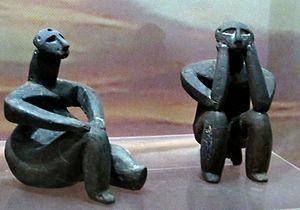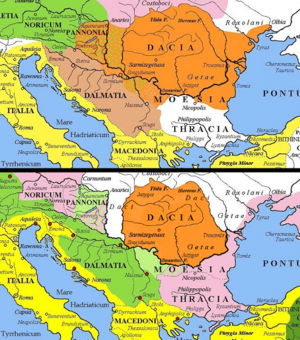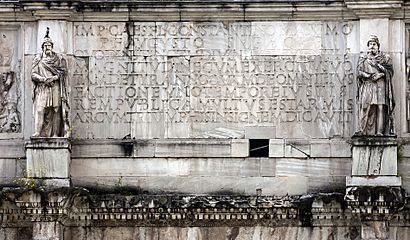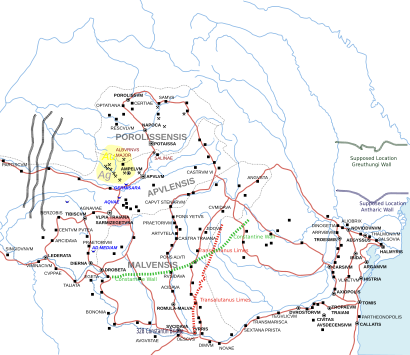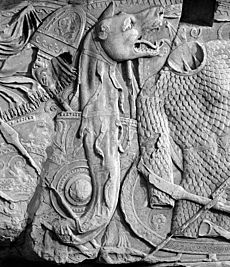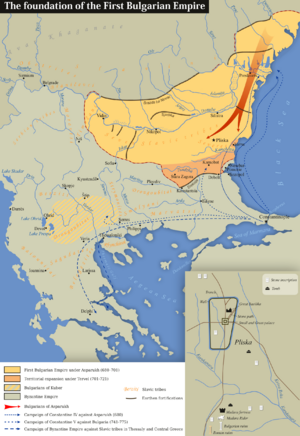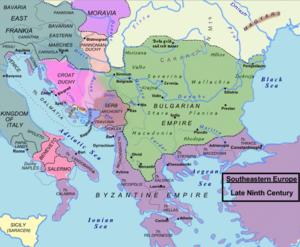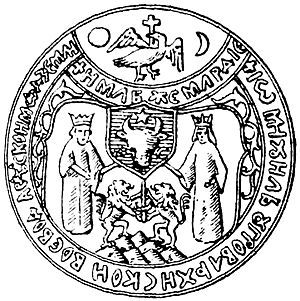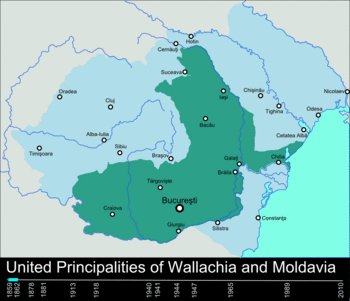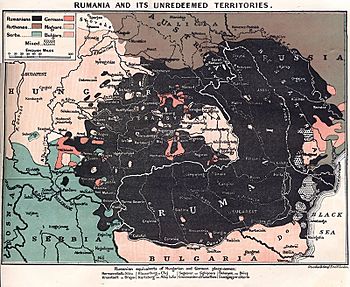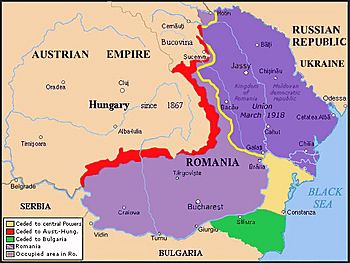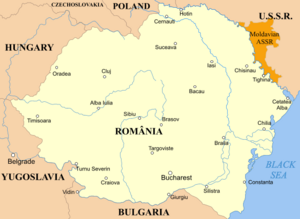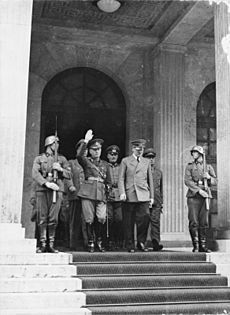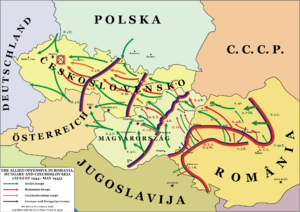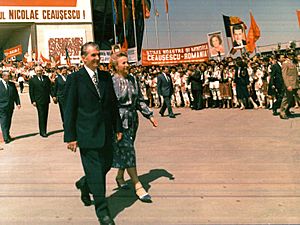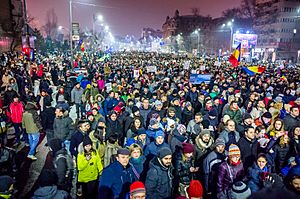History of Romania facts for kids
This article tells the story of Romania from ancient times to today, explaining how it became the country it is now.
Contents
- Ancient Times: Prehistory in Romania
- The Dacians: Brave Warriors of Ancient Romania
- Early Middle Ages in Romania
- High Middle Ages in Romania
- Early Modern Period in Romania
- Independence and the Kingdom of Romania
- World War I
- Greater Romania (1918–1940)
- World War II and Aftermath (1940–1947)
- Communist Period (1947–1989)
- 1989 Revolution
- Transition to Free Market (1990–2004)
- NATO and European Union Membership (2004–Present)
- Romanian Rulers
- See also
Ancient Times: Prehistory in Romania
Imagine people living in Romania over 34,000 years ago! Their bones were found in a place called Peștera cu Oase (which means "Cave with Bones") in 2002. These are some of the oldest human remains found in Europe.
Later, during the Stone Age, a very old civilization called the Cucuteni–Trypillia culture lived in northeastern Romania. They were one of Europe's first big cultures. They even had the earliest known salt works at Poiana Slatinei, where they got salt from spring water.
The Dacians: Brave Warriors of Ancient Romania
The Dacians were a group of people related to the Thracians. They lived in the area that is now Romania, Moldova, and parts of other nearby countries. The ancient Greeks called them Getae, and the Romans called them Dacians.
The first written mention of these people comes from a Greek historian named Herodotus around 440 BC. He said the Dacians were the bravest and most law-abiding of the Thracians. They believed they were immortal, thinking that when they died, they would go to a divine being named Zalmoxis.
The Dacians spoke a language similar to Thracian. They were also influenced by their neighbors, the Scythians and the Celts.
Famous Dacian Kings
The Dacian lands often had different rulers. One of the most famous was King Burebista, who ruled from 82 BC to 44 BC. He made the Dacian kingdom very large, stretching from the Black Sea to the Tisa River. He also reorganized the army and made his people follow strict rules.
Burebista even conquered some Greek towns on the Black Sea. He moved the Dacian capital to Sarmizegetusa Regia. This city became very important, especially under a later king, Decebalus. Julius Caesar, a famous Roman leader, even thought about invading Dacia, but he died before he could. After Burebista's death, his large kingdom split into smaller parts.
Another important Dacian king was Decebalus, who ruled from 87 AD to 106 AD. His name means "strong as ten men." He was a very skilled leader and fought two wars against the powerful Roman Empire.
Wars with the Roman Empire
The Dacians often raided Roman lands. To stop this, Roman emperors like Tiberius and Caligula sometimes paid the Dacians money. But this didn't last.
In 85 AD, the Dacians under Decebalus attacked the Roman province of Moesia. The Romans sent troops, but the Dacians defeated them. After this, Decebalus became a "client king" of Rome. This meant he got military help, craftsmen, and money from Rome, but Dacia remained mostly independent.
However, the Roman Emperor Trajan wanted to conquer Dacia completely. He wanted Dacia's gold mines and to end the peace treaty, which he saw as embarrassing. In 101–102 AD, Trajan attacked Dacia. He besieged the Dacian capital, Sarmizegethusa, and took over part of the country.
Decebalus tried to rebuild his power and attacked Roman forts again in 105 AD. Trajan returned, attacked Sarmizegethusa, and destroyed it. A new Roman city, Ulpia Traiana Sarmizegetusa, was built on its ruins. Dacia became a Roman province called Dacia Traiana.
The Dacian warriors used a special curved sword called a falx. This weapon was so powerful that it forced the Roman army to change their armor and fighting style. The story of these wars is shown on Trajan's Column in Rome.
Roman Dacia (106–275 AD)
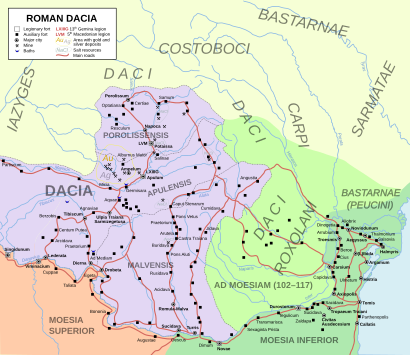
Roman Dacia was a very important province for the Roman Empire. Many Romans moved there to live. New mines were opened, and farming and trade grew. Dacia became a land of cities, many of which started as Roman army camps.
People from all over the Roman Empire came to live in Dacia. They brought their Roman way of life and the Latin language, which became the main language. Dacian men also joined the Roman army and fought in different parts of the empire, from Britain to the Middle East.
The Romans built walls and forts to protect Dacia. However, Germanic tribes like the Goths started to attack the province. Eventually, in 275 AD, the Roman Emperor Aurelian decided to pull Roman troops out of Dacia. The Roman citizens living there were moved to other Roman areas south of the Danube River.
Constantine's Attempts to Reclaim Dacia
Later, in 328 AD, the Roman Emperor Constantine the Great tried to regain control of Dacia. He even built a large bridge over the Danube River. He fought against tribes like the Goths and Sarmatians, winning some victories and extending Roman influence again. Constantine took the title Dacicus Maximus in 336 AD.
After the Romans fully left, different groups like the Huns, Gepids, Lombards, and Avars ruled the area. Slavic people also arrived.
The Name of the Dacians
The Dacians were called Geta by the ancient Greeks and Dacus by the Romans. Sometimes, these names were used interchangeably. Modern historians often use the term Geto-Dacians to refer to them. Both Greeks and Romans noted that the Getae and Dacians spoke the same language.
Dacian Beliefs
The Dacians had a strong religion. They believed in the immortality of the soul and thought that death was just a journey to another place. Their main god was Zalmoxis, and their chief priest was very important. Some historians believe the Dacians might have seen themselves as "wolves" or had special rituals related to wolves.
Another important goddess was Bendis, the goddess of the moon and hunting. Her worship even spread to Athens, Greece.
Early Middle Ages in Romania
After the Romans left Dacia (around 271-275 AD), the Goths invaded. Later, the Huns, Gepids, Avars, and Bulgars also ruled parts of the land. The areas of Wallachia and Moldavia were under the control of the First Bulgarian Empire for a long time, starting in 681 AD.
The Bulgarians built large ditches to protect their northern borders. Later, under Khan Krum, the Bulgarian Empire grew even larger, reaching from the Danube River to north of Budapest.
Other groups like the Pechenegs, Cumans, and Uzes also lived in the territory of Romania during this time. These groups were present until the Romanian states of Wallachia and Moldavia were formed in the 1300s.
High Middle Ages in Romania

During the High Middle Ages, nomadic groups like the Pechenegs and Cumans controlled the lands north of the Black Sea.
It's debated whether the people who became modern Romanians stayed in Transylvania after the Romans left or if they moved there later from the Balkan Peninsula.
The Second Bulgarian Empire also had influence over the lands of Wallachia. Hungarian kings invited settlers from Central and Western Europe, like the Saxons, to live in Transylvania. The Székelys were brought in as border guards.
Famous Romanian Rulers
Vlad III the Impaler, also known as Vlad Dracula, was a ruler of Wallachia in the 1400s. He is remembered for fighting against the Ottoman Empire and for trying to keep his country free. In the Western world, he is famous as the inspiration for the character Count Dracula. In Romania, he is seen as a fierce but fair ruler who defended Wallachia.
Stephen the Great was a very successful ruler of Moldavia. He ruled for 47 years and was a great military leader. He won many battles, including a famous victory over the Ottoman Empire in 1475 at the Battle of Vaslui. He built many churches and monasteries to celebrate his victories. Because of his fight against the Ottomans, Pope Sixtus IV called him a "true Champion of the Christian Faith."
After Stephen's death, Moldavia, like Wallachia, gradually came under the control of the Ottoman Empire.
Early Modern Period in Romania
By 1541, the Ottoman Empire controlled much of the Balkan Peninsula. Moldavia, Wallachia, and Transylvania became Ottoman territories but kept some self-rule. However, some Romanian cities were directly controlled by the Ottomans.
During this time, leaders like Michael the Brave tried to unite the Romanian lands. Michael the Brave was the Prince of Wallachia, Transylvania, and Moldavia for a short time around 1600. After his death, this union broke apart.
Transylvania had a "golden age" under Prince Gábor Bethlen in the early 1600s. Later, in 1690, the Habsburg monarchy (from Austria) took control of Transylvania. They also took parts of Wallachia and Moldavia, like Oltenia and Bukovina. In 1812, Russia took the eastern half of Moldavia, called Bessarabia.
During Austrian-Hungarian rule, Romanians were the majority in Transylvania. However, there were tensions with the Hungarians due to policies that tried to make everyone speak Hungarian.
After a war with Russia, the Ottoman Empire gave back some Danube ports to Wallachia. The Romanian lands gained more political freedom. Their rulers were elected for life, which helped reduce outside interference. From 1829 to 1844, Russian forces occupied the Romanian lands. During this time, the first Romanian constitution was written.
Revolutions of 1848 and the Start of Modern Romania

In 1848, there were revolutions in Moldavia, Wallachia, and Transylvania. People wanted full independence for Moldavia and Wallachia and equal rights for Romanians in Transylvania. These goals were not fully met, but the uprisings showed Romanians how much they shared in language and interests. This helped them realize they were one people.
The United Principalities
After the 1848 revolutions, the major European powers didn't want Romania to unite into one state. So, Romanians decided to work towards it themselves.
After Russia's defeat in the Crimean War (1856), the Treaty of Paris allowed Moldavia and Wallachia to elect their own princes. However, the treaty didn't say the same person couldn't be prince of both! So, in 1859, Alexandru Ioan Cuza was elected as Domnitor (Ruling Prince) of both Moldavia and Wallachia. This united the two principalities.
Cuza started many reforms, like ending serfdom (a system where peasants were tied to the land). He also began to merge the governments and parliaments. In 1862, the country was officially named the United Principalities of Romania.
This new Romania did not include Transylvania. In Transylvania, the upper class was mostly Hungarian, and Romanian nationalism often clashed with Hungarian nationalism. Austria-Hungary kept tight control over Transylvania.
Independence and the Kingdom of Romania
In 1866, Alexandru Ioan Cuza was forced to leave, and Prince Karl of Hohenzollern-Sigmaringen became the new ruler. He was known as Prince Carol of Romania.
Romania declared its full independence from the Ottoman Empire after the Russo-Turkish War (1877–1878). In the 1878 Treaty of Berlin, Romania was officially recognized as an independent state by the major European powers. Romania gave up the Bessarabia region to Russia but gained access to the Black Sea ports and the Dobruja region.
In 1881, Romania became a kingdom, and Prince Carol became Carol I of Romania. The time between 1878 and 1914 was peaceful and saw progress for Romania.
World War I
Before World War I, Romania had a secret alliance with Germany and Austria-Hungary. However, when the war started in 1914, Romania decided to stay neutral. This was because the attacks on Austria were not "unprovoked," as the treaty required.
King Carol I died in 1914, and his nephew, King Ferdinand I of Romania, became king. Ferdinand was more open to joining the Allies. In August 1916, Romania joined the Allies (Britain, France, Russia) in the war. The main goal for Romania was to gain Transylvania, which had a large Romanian population but was part of Hungary.
The Allies promised Romania regions like Bukovina, Transylvania, and Banat. This decision was very popular in Romania. The Romanian army attacked Austria-Hungary in Transylvania. They had some early success, but when the German army arrived, the Romanians were pushed back. On the southern front, German, Bulgarian, and Turkish forces occupied Dobruja and captured Giurgiu. Bucharest, the capital, was occupied by the Central Powers in December 1916.
In 1917, the Romanian army fought bravely in battles like Mărăști, Mărășești, and Oituz. They managed to stop the Central Powers' attacks and even regain some land. Their motto was "Pe aici nu se trece" (meaning "No Trespassing!" or "One does not pass through here"). These battles were very important for the Romanian army.
However, the Russian Revolution in October 1917 forced Russia out of the war. This left Romania alone on the Eastern Front, surrounded by the Central Powers. Romania was forced to sign the Treaty of Bucharest in May 1918. Under this treaty, Romania lost Dobruja to Bulgaria and some Carpathian passes to Austria-Hungary. It also had to lease its oil reserves to Germany. However, the Central Powers recognized Romania's union with Bessarabia, which had declared independence from Russia.
King Ferdinand refused to sign the treaty, hoping the Allies would win. In October 1918, Romania re-entered the war. The next day, the Treaty of Bucharest was canceled. Around 748,000 Romanians, both soldiers and civilians, died during World War I.
Romanians in Austria-Hungary
Many Romanians from Transylvania and Bukovina fought in the Austro-Hungarian army. While many were loyal at first, some started to desert after Romania joined the war. They didn't want to fight against their fellow Romanians. Many Romanian prisoners of war in Russia and Italy later formed volunteer legions to fight for Romania.
Greater Romania (1918–1940)
After World War I, Romania grew much larger. The idea of a "Greater Romania" had been a dream for a long time. It meant uniting all Romanians into one country. This dream became a reality in 1918.
- Bukovina joined Romania after the Treaty of Saint Germain in 1919.
- Bessarabia also joined Romania in 1920.
- On December 1, 1918, Romanians from Transylvania, Banat, Crișana, and Maramureș voted to unite with Romania. This day is now a national holiday called Great Union Day.
The new "Greater Romania" was almost 300,000 square kilometers (about 115,000 square miles). It included all the historic Romanian lands. The new borders were confirmed by treaties like the Treaty of Trianon (with Hungary) and the Treaty of Versailles (with Bukovina and Bessarabia). Romania also gained Southern Dobruja from Bulgaria in 1913.
While most people in Greater Romania were Romanians (71.9% in 1930), there were also many minorities, including Hungarians, Germans, Jews, Ukrainians, and Bulgarians. These minorities made up about 28% of the population. The 1923 Constitution recognized national minorities, and they had representatives in Parliament.
Challenges in the 1930s
The worldwide Great Depression hit Romania hard in the early 1930s. There was a lot of unemployment and strikes. The government sometimes used force to stop these protests.
Romania's democracy became weaker during the 1930s. King Carol II of Romania took more power and created a "royal dictatorship" in 1938. He tried to control the country and dealt harshly with groups like the Iron Guard, a fascist and ultra-nationalist party. Leaders of the Iron Guard were arrested and some were killed.
In 1939, Germany and the Soviet Union signed the Molotov–Ribbentrop Pact, which secretly agreed that the Soviet Union could take Bessarabia.
World War II and Aftermath (1940–1947)
After World War I, Romania had become much larger. But this also caused problems with its neighbors, who had lost land to Romania. To protect itself, Romania joined alliances like the Little Entente and the Balkan Entente.
In the 1930s, Romania's government became more like a dictatorship under King Carol II. The country also started to move closer to Nazi Germany.
In 1940, Romania lost much of the land it had gained after World War I:
- In July, the Soviet Union demanded Bessarabia and northern Bukovina, and Romania had to give them up.
- In August, Germany and Italy forced Romania to give Northern Transylvania to Hungary.
- In September, Southern Dobruja was given back to Bulgaria.
These losses made King Carol II very unpopular. He was forced to step down, and his 19-year-old son, Michael, became king. General Ion Antonescu became the new leader with full power. Romania officially joined the Axis powers (Germany, Italy, Japan) in November 1940.
On June 22, 1941, Germany and Romania attacked the Soviet Union. Romania wanted to get back Bessarabia and northern Bukovina. Romanian armies fought alongside the Germans deep into the Soviet Union, reaching places like Odessa, Sevastopol, and Stalingrad. Romania sent the second-largest number of troops to the Eastern Front after Germany.
King Michael's Coup
By August 1944, the Soviet army was advancing into Romania. On August 23, 1944, King Michael I led a successful coup (a sudden takeover of power) against the Axis. He had support from politicians and the army. King Michael removed Antonescu from power and declared war on Germany.
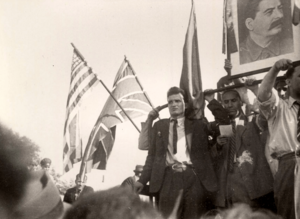
This coup helped the Soviet army advance faster into Romania. About 130,000 Romanian soldiers were captured by the Soviets. An armistice (a peace agreement) was signed on September 12, 1944. Romania surrendered to the Soviet Union and was occupied by Allied forces, with the Soviets in control.
Romanian and Soviet forces then fought together against Germany. They entered Transylvania, Hungary, Yugoslavia, Austria, and Czechoslovakia. The Romanian army suffered heavy losses, with about 167,000 soldiers killed, wounded, or missing while fighting the Axis.
Under the 1947 Treaty of Paris, Romania had to pay $300 million to the Soviet Union for war damages. Northern Transylvania was returned to Romania, but the borders with the Soviet Union and Bulgaria were set back to how they were in January 1941.
After World War II, the Soviet occupation helped the Communist Party gain power.
Communist Period (1947–1989)
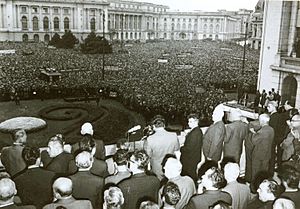
After World War II, the Communist Party became very powerful in Romania due to Soviet influence. King Michael I was forced to step down and go into exile. Romania was declared a "people's republic" and remained under Soviet control until the late 1950s. During this time, the Soviet Union took many of Romania's resources.
Gheorghe Gheorghiu-Dej was Romania's leader from 1948 to 1965. Under his rule, banks and large businesses were taken over by the state. The Communist government also began to collectivize agriculture, meaning private farms were turned into large state-controlled farms. Many people who were against the Communists, especially intellectuals and former elites, were arrested and imprisoned.
In 1958, Soviet troops left Romania. Under its new leader, Nicolae Ceauşescu, Romania began to follow more independent policies. For example, Romania was the only Warsaw Pact country that did not take part in the Soviet-led invasion of Czechoslovakia in 1968. Romania also kept diplomatic relations with Israel and established ties with West Germany.
However, Ceauşescu's rule became very strict and harsh. He borrowed a lot of money from other countries, and then tried to pay it all back quickly. To do this, he put in place very strict austerity policies, which made life very difficult for Romanians. He also greatly increased the power of the Securitate (secret police) and created a "cult of personality" around himself and his wife. This meant he was praised constantly, and his image was everywhere.
This led to a huge drop in his popularity. The foreign debt was finally paid off in 1989, just before his overthrow and execution in the Romanian Revolution in December 1989.
1989 Revolution
The Romanian Revolution in December 1989 was bloody, with over 1,000 deaths. It led to the fall of Ceauşescu and the end of Communist rule. After protests in Timişoara, a large rally in Bucharest on December 21, 1989, turned against Ceauşescu. He and his wife tried to escape by helicopter but were captured by the army.
They were quickly tried and found guilty of crimes like genocide. They were executed on December 25, 1989.
Ion Iliescu, a former Communist official who had been sidelined by Ceauşescu, became the leader of a new government called the National Salvation Front (FSN). This group announced the start of democracy and civil liberties.
Transition to Free Market (1990–2004)
After Ceauşescu's fall, the National Salvation Front (FSN) began to introduce democratic and free market changes. Petre Roman, a university professor, became prime minister. He started some free market reforms. Old political parties from before the war were also restarted.
In April 1990, protests began in Bucharest, with people questioning the government's legitimacy. They accused the FSN of being made up of former Communists. Elections were held in May 1990, and Ion Iliescu won with 85% of the vote. The FSN also won most seats in Parliament.
Some protesters continued to demonstrate, saying the results were unfair. The protests became violent, with some attacking police and government buildings. Ion Iliescu called on "men of good will" to defend state institutions. Thousands of coal miners came to Bucharest, and there were clashes. Later investigations showed that government intelligence agents were involved in stirring up trouble.
In December 1991, a new constitution was written and approved. In 1992, the FSN split into two groups. Ion Iliescu won the presidential elections again in September 1992. His party, which later became the Social Democratic Party (PSD), governed Romania until 1996.
In 1996, Emil Constantinescu won the presidential election. A new government was formed, which included several parties. This government tried to make important reforms.
In the 2000 election, Iliescu's Social Democratic Party returned to power, and Iliescu won a third term as president. Adrian Năstase became prime minister.
In 2004, Traian Băsescu was elected president. His party formed a coalition government.
NATO and European Union Membership (2004–Present)
After the Cold War, Romania built stronger ties with Western Europe. It joined NATO (North Atlantic Treaty Organization) in 2004.
In 2004, Traian Băsescu was elected president for his first term. A new coalition government was formed.
Romania applied to join the European Union (EU) in 1993. It became a full member on January 1, 2007.
Many Romanians have moved to other countries like Italy, Germany, Spain, and the United Kingdom since the 1990s. This is due to new travel freedoms and economic difficulties.
In April 2008, Bucharest hosted a major NATO summit.
In 2009, President Traian Băsescu was re-elected for a second term.
In January 2012, Romania saw large national protests against proposed health reforms and general unhappiness with the government.
In 2014, Klaus Iohannis was elected as the President of Romania. He was re-elected in 2019.
In December 2020, the Social Democrats (PSD) won the parliamentary election. In November 2021, Nicolae Ciucă became the new prime minister, leading a coalition government.
Romanian Rulers
- List of Wallachian rulers (up to 1859)
- List of Moldavian rulers (up to 1859)
- List of Transylvanian rulers (up to 1867)
- Kings of Romania (1881–1947)
- Presidents of Romania (since 1947)
- Prime ministers of Romania (since 1862)
See also
 In Spanish: Historia de Rumania para niños
In Spanish: Historia de Rumania para niños
- Historical regions of Romania
- List of Dacian kings
- Military history of Romania
- Politics of Romania


